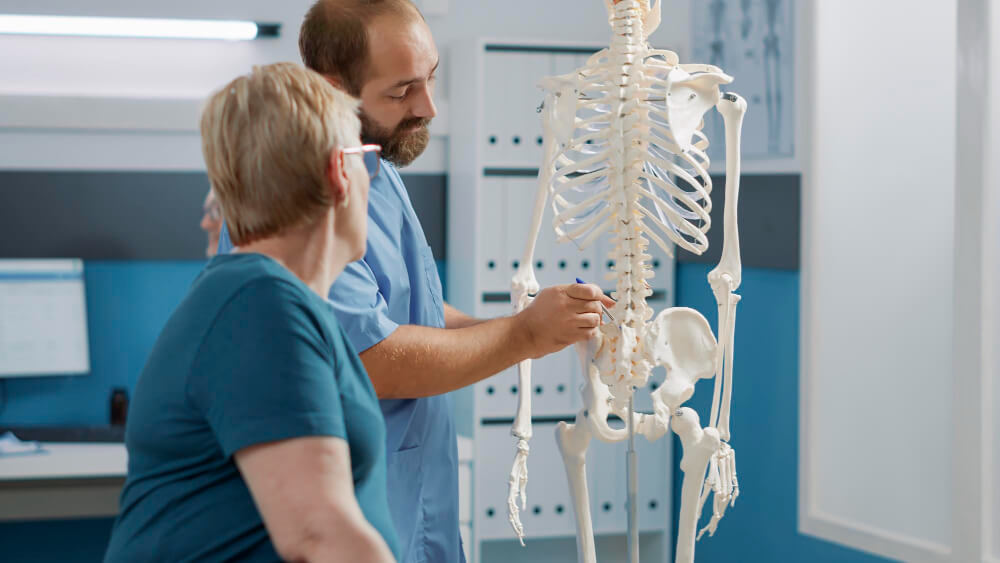When Your Spine Cries Out: Finding Solace and Solutions with a Neurosurgeon and Spinal Fusion
The rhythmic sway of your spine carries you through life’s journey, but when pain disrupts that rhythm, the melody turns to a discordant ache. This article delves into the realm of spinal fusion, a potential solution for chronic spinal pain, and introduces you to the conductor of this process: the neurosurgeon.
When the Dance Turns Disjointed: Recognizing the SOS of Spinal Pain Needing Fusion
Before seeking the expertise of a neurosurgeon for spinal fusion, understanding the telltale signs of severe, chronic spinal pain is key:
- Persistent Pain: Pain that lingers for months, worsens with activity, and disrupts sleep necessitates a doctor’s evaluation.
- Stiffness and Limited Mobility: Difficulty bending, squatting, or climbing stairs due to spinal stiffness could indicate significant joint damage.
- Deformity: Visible bowing or misalignment of the spine joint may signal advanced arthritis or instability requiring surgical intervention.
- Ineffectiveness of Conservative Measures: If physical therapy, medication, injections, and lifestyle modifications haven’t provided significant relief, a surgeon might recommend fusion.
Inside the Neurosurgeon’s Symphony: Demystifying the Diagnosis and Journey to Spinal Fusion
Your journey with a neurosurgeon for spinal fusion unfolds in these stages:
- Medical History and Examination: Discussing your symptoms, medical history, and lifestyle helps the surgeon understand the potential cause of your pain and suitability for surgery.
- Diagnostic Tests: X-rays, MRIs, CT scans, and nerve tests assess the extent of joint damage, rule out other conditions, and inform the surgical plan.
Treatment Discussion: Based on the diagnosis and your individual needs, the surgeon will discuss the benefits and risks of spinal fusion and answer any questions you might have. - Pre-Surgical Preparations: Stopping certain medications, adjusting lifestyle habits, and completing pre-operative tests ensure optimal readiness for surgery.
Tuning the Treatment Symphony: From Pre-Surgery to Recovery, Exploring Spinal Fusion Options
Neurosurgeons offer a diverse range of instruments to harmonize your spinal function:
Pre-Surgical Options:
- Physical Therapy and Strengthening Exercises: Building muscle strength and improving flexibility can support recovery and joint stability after surgery.
- Weight Management: Losing weight can lessen the burden on your spine and improve surgical outcomes.
- Quitting Smoking: Smoking slows down healing and increases the risk of complications after surgery.
Surgical Techniques:
- Lumbar Spinal Fusion: Fusing bones in the lower spine to stabilize the joint and alleviate pain is the most common procedure.
- Cervical Spinal Fusion: For problems in the neck area, fusing vertebrae offers pain relief and stability.
- Minimally Invasive Surgery: Using smaller incisions and specialized tools can speed up recovery and reduce tissue damage.
- Robotic-Assisted Surgery: Robotic technology can enhance precision and accuracy during surgery, potentially leading to faster recovery and improved outcomes.
Post-Surgical Care and Rehabilitation:
- Pain Management: Medication and therapy will help manage discomfort during recovery.
- Physical Therapy: A structured rehabilitation program is crucial for regaining strength, flexibility, and range of motion in your newly fused spine.
- Follow-up Appointments: Monitoring progress, adjusting recovery plans, and addressing any concerns are essential for optimal healing and long-term spinal health.
Beyond the Final Note: The Continued Chorus of Management and Lifestyle Adjustments
Spinal fusion is not a one-time performance. Neurosurgeons emphasize proactive management:
- Maintaining a Healthy Weight: Continued weight management reduces stress on your spine and protects your new fusion.
- Regular Exercise: Maintaining an active lifestyle with low-impact exercises strengthens muscles and promotes spinal health.
- Monitoring for Wear and Tear: Over time, spinal implants might require revision surgery. Regular checkups allow early detection and timely action.
Conclusion:
Chronic spinal pain can disrupt your life’s harmony, but seeking the expertise of a neurosurgeon empowers you to rewrite the melody. Through careful diagnosis, personalized treatment, and ongoing support, you can reclaim your spinal function, rediscover the joy of movement, and regain control of your well-being. Remember, early intervention, comprehensive care, and proactive management are the chords that harmonize your path to pain-free movement and renewed resilience.


